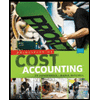Overhead estimates for the year are broken down as follows: Materials handling Cost Driver Estimated overhead Estimated number of costs deliver units 50,000 kilos Cost. Materials Handling Production setups Quality inspections Machine depreciation Number of kilos Number of runs Inspection hours P400,000 P900,000 P300,000 P400,000 300 runs 4,000 hours 10,000 hours Machine hour Total estimated head Determine the following: 5. Predetermined annual overhead rates for Activity-based costing (Materials Handling) 6. Predetermined annual overhead rates for Activity-based costing (Production setups) 7. Predetermined annual overhead rates for Activity-based costing (Quality inspections)
Overhead estimates for the year are broken down as follows: Materials handling Cost Driver Estimated overhead Estimated number of costs deliver units 50,000 kilos Cost. Materials Handling Production setups Quality inspections Machine depreciation Number of kilos Number of runs Inspection hours P400,000 P900,000 P300,000 P400,000 300 runs 4,000 hours 10,000 hours Machine hour Total estimated head Determine the following: 5. Predetermined annual overhead rates for Activity-based costing (Materials Handling) 6. Predetermined annual overhead rates for Activity-based costing (Production setups) 7. Predetermined annual overhead rates for Activity-based costing (Quality inspections)
Managerial Accounting
15th Edition
ISBN:9781337912020
Author:Carl Warren, Ph.d. Cma William B. Tayler
Publisher:Carl Warren, Ph.d. Cma William B. Tayler
Chapter2: Job Order Costing
Section: Chapter Questions
Problem 4BE: Applying factory overhead Bergan Company estimates that total factory overhead costs will be 620,000...
Related questions
Question

Transcribed Image Text:Problem B: ABC Company provided the following information for the month of September 2008. Factory
overhead is applied at the rate of 100% based on direct labor cost. The estimate overhead for the month
amounts to P160,500.
Model A
Model B
Unit produced
Direct materials cost per unit
450
800
P400
P600
Direct labor cost per unit
P90
P150
Activities
Materials handling
Production set ups
Quality inspection
Machine depreciation
900 kilos
3,200 kilos
9 runs
15 runs
80 hours
120 hours
280 hours
506 hours
Overhead estimates for the year are broken down as follows:
Materials handling
Cost Driver
Estimated number of
Estimated overhead
costs deliver units
50,000 kilos
Cost.
Materials Handling
Number of kilos
P400,000
Production setups
Number of runs
300 runs
P900,000
Quality inspections
Machine depreciation
Inspection hours
4,000 hours
P300,000
Machine hour
10,000 hours
P400,000
Total estimated head
Determine the following:
5. Predetermined annual overhead rates for Activity-based costing (Materials Handling)
6. Predetermined annual overhead rates for Activity-based costing (Production setups)
7. Predetermined annual overhead rates for Activity-based costing (Quality inspections)
8. Predetermined annual overhead rates for Activity-based costing (Machine depreciation)
9. Overhead costs assigned to Model A using activity-based costing
10. Overhead costs assigned to Model B using activity-based costing
11. Cost per unit of Model A using the activity-based costing
12. Cost per unit of Model B using the activity-based costing
13. Cost per unit of Model A using the traditional approach.
14. Cost per unit of Model B using the traditional approach.
Expert Solution
This question has been solved!
Explore an expertly crafted, step-by-step solution for a thorough understanding of key concepts.
Step by step
Solved in 2 steps

Recommended textbooks for you

Managerial Accounting
Accounting
ISBN:
9781337912020
Author:
Carl Warren, Ph.d. Cma William B. Tayler
Publisher:
South-Western College Pub

College Accounting, Chapters 1-27
Accounting
ISBN:
9781337794756
Author:
HEINTZ, James A.
Publisher:
Cengage Learning,

Principles of Cost Accounting
Accounting
ISBN:
9781305087408
Author:
Edward J. Vanderbeck, Maria R. Mitchell
Publisher:
Cengage Learning

Managerial Accounting
Accounting
ISBN:
9781337912020
Author:
Carl Warren, Ph.d. Cma William B. Tayler
Publisher:
South-Western College Pub

College Accounting, Chapters 1-27
Accounting
ISBN:
9781337794756
Author:
HEINTZ, James A.
Publisher:
Cengage Learning,

Principles of Cost Accounting
Accounting
ISBN:
9781305087408
Author:
Edward J. Vanderbeck, Maria R. Mitchell
Publisher:
Cengage Learning

Principles of Accounting Volume 2
Accounting
ISBN:
9781947172609
Author:
OpenStax
Publisher:
OpenStax College

Managerial Accounting: The Cornerstone of Busines…
Accounting
ISBN:
9781337115773
Author:
Maryanne M. Mowen, Don R. Hansen, Dan L. Heitger
Publisher:
Cengage Learning

Cornerstones of Cost Management (Cornerstones Ser…
Accounting
ISBN:
9781305970663
Author:
Don R. Hansen, Maryanne M. Mowen
Publisher:
Cengage Learning